Looking for some help with my BMC-40. I have been getting an "Servo Driver Fault on Axis S" error when my tool is done with the cut and is retracting to make a tool change. It seems to be the tools that have the rpm over 1000. It almost seems that the brake is failing somehow. But when it does its' retract, it faults out, shuts the spindle down and free spins to a stop. The error on the screen (Ultramax 3) reads Servo Driver Fault on Axis S". The LED error on the drive board in the back reads "OV" for over voltage. The Serial # is BL-9002090A on machine and NS80581-005-1 on drive cabinet. Manufacure of the drive Starts with a Y. I have a picture of the drive but I do not know how to post it. There were some guys that had similar problems in this forum but never posted how their problem was solved. Any info or help would be greatly appreciated. Thank you.
Rofuth
Results 1 to 9 of 9
-
08-31-2011, 12:24 AM #1
 Registered
Registered
- Join Date
- Sep 2007
- Posts
- 17
Hurco BMC 40-Servo Driver fault on axis S
-
08-31-2011, 06:01 PM #2
 Registered
Registered
- Join Date
- Feb 2010
- Posts
- 163
OV = Overvoltage which means there's something up with the braking resistor or its circuits.
Look inside the drive cabinet for the brake resistor. It will be connected to the spindle drive with two big & two small wires. With the power off, disconnect the two big wires from the spindle drive to the resistor and check its resistance with a meter. It should be pretty low, say between 4 and 50 Ohms. (Let us know what you measured.) The skinny wires are a temperature sensor, so don't worry about them - you might not even have them. The brake resistor on my machine, with a Fanuc spindle drive, is a square metal can about 4" x 10" x 2" or so. I think you have a Yaskawa spindle drive as that's the only one that comes to mind that starts with a Y. (OK, Yansac too, but not in a machine this old).
If it measures in this range (it probably will), the resistor is OK and the problem will be in the spindle drive iteself. We will need to know more about the spindle drive.
How the spindle brake works is there's a transistor in the spindle drive that gets turned on to dump the excess power (voltage) from the motor slowing down into the brake resistor. If this transistor or the brake resistor fails the excess power doesn't have anywhere to go so the voltage builds up in the drive's DC bus which trips the drive's Overvoltage alarm.
I think the Yaskawa drives use a bunch of separate transistor modules so if one is bad it shouldn't be too bad to fix.
PS, thanks for starting a new thread!
-
09-01-2011, 03:03 AM #3
 Registered
Registered
- Join Date
- Sep 2007
- Posts
- 17
Well the problem kept getting progressively worse until the spindle blew the breaker on the Yaskawa spindle drive. I could reset it but the moment that I would try to reset the servo and spindle, it would shut down, even trip my digital phase converter out. I'm pretty sure that my problem is a direct short in the spindle drive. I have a new one coming in and will post the results soon. Thanks Fasto for the input. Much appreciated.
-
09-01-2011, 03:34 PM #4
 Registered
Registered
- Join Date
- Feb 2010
- Posts
- 163
I'm 99% sure that the OV trouble lead to burning out a drive transistor on the spindle drive, which makes it a dead short.
If you don't need to send the old drive back, let me know. I'd like to find out if my diagnosis is correct.
-
09-03-2011, 04:51 AM #5
 Registered
Registered
- Join Date
- Sep 2007
- Posts
- 17
what does that Transistor look like? What is the root cause of that to break down? This is the 2nd time my spindle drive has went down. The first time I was able to aquire a used back part of the chasis and reused my drive board and orient board. So when it went out this time, I figured the other was used and was about to go. I decided to go rebuilt this time to get new transistor packs.. But now I am wondering if there isn't something going on that is causing this reoccurance. What does anyone think? I still have the original back chasis that went out the first time. I just don't know what I am looking for.
-
09-06-2011, 01:50 PM #6
 Registered
Registered
- Join Date
- Feb 2010
- Posts
- 163
I still don't know for sure what kind of drive you've got. That said, the transistors are usually white plastic devices with either 2 or 3 big screw terminals on top, and 2, 3 or 4 smaller terminals. The brake transistor will have 2 big screw terminals and probably 2 smaller terminals. The transistors for the drive will have three big screw terminals and probably 3 smaller terminals.
There will be one brake transistor and either 3 or 6 drive transistors. There will also be a three-phase rectifier with will have five terminals on it.
If you follow the motor terminals on the outside of the drive back into the wiring they'll got to the drive transistors. Search "three phase H-Bridge" to see how the transistors are wired.
If you follow the brake resistor terminals on the outside of the drive back through the wiring one terminal will go to the brake transistor and the other will go to the big capacitor.
With the power off, use a multimeter set on Ohms, check the resistance between all the terminals on each transistor (check them separately). If any read as 0 ohms they're shorted.
Why this has happened twice I can't say. If you're running from an RPC you might have extra high voltage on the generated leg. If you're using utility three-phase you might have high voltage on all legs and need to adjust your step-down transformer. You are using a step-down transformer? Most of the Japanese electrical equipment needs 200V, not 208V or 220V, and certainly not 240V. Running it on 220V can cause overvoltage and other trouble so almost always a step-down transformer is needed.
-
09-07-2011, 03:40 AM #7
 Registered
Registered
- Join Date
- Sep 2007
- Posts
- 17
Thanks Fasto for the response. The voltage statement that you said has me concerned. On the rear of the machine, it states 240 v 3-phase. I am running a phase perfect digital phase converter so I have near perfect phase. I can test at any given time and it is running at 239v + 1/-0 at all times. I have pics of the transistor packs, maybe you will know by the pics. I installed the refurbished spindle drive and the machine picked up where she left off without a hitch. I would really like to know which transistors are the problem so I can have them on the shelf if there is a next time. Thanks for your help. It took me a bit but I have the pics uploaded.
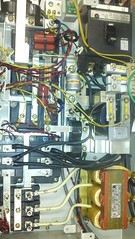
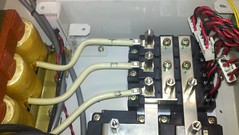
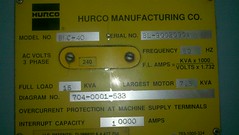
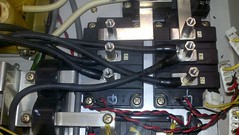
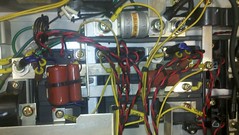
-
09-08-2011, 05:56 PM #8
 Registered
Registered
- Join Date
- Sep 2007
- Posts
- 17
Well, I was checking voltage at the fuse location as it entered the machine. I didn't realise that it goes through a stepdown transformer on the side of machine and enters the spindle drive at 190 V. I feel better about that.
-
09-09-2011, 02:01 PM #9
 Registered
Registered
- Join Date
- Feb 2010
- Posts
- 163
I was going to mention that there's a stepdown transformer usually included with the machine - sometimes these get lost when you buy a used machine.
Most of the Japanese drives need no more than 200V in because that's the standard Japanese three-phase voltage.
The pictures are pretty small and it's hard to tell what's what. Can you get a bigger copy of the first picture?
Does your machine have an AC spindle motor or a DC spindle motor? You can tell by counting the number of power wires that go to the motor. The power wires will be connected to a terminal strip on the drive. There will be 2 power wires plus a ground wire for a DC motor, and three power wires plus a ground for an AC spindle motor. There will be other small wires as well so don't count those.
Similar Threads
-
Hurco KM3-P Servo Fault
By nuzmeed in forum HURCOReplies: 4Last Post: 09-26-2011, 04:11 PM -
SERVO DRIVE FAULT ON AXIS S BMC 40
By tallenttoolroom in forum HURCOReplies: 6Last Post: 08-30-2011, 09:59 PM -
VMC15 fadal, 88HS error#9, spindle driver fault, servo amplifier fault
By kin73 in forum SpanishReplies: 3Last Post: 05-18-2011, 05:26 AM -
hurco vm1 x axis fault
By merv385 in forum HURCOReplies: 5Last Post: 11-23-2009, 09:20 PM






 Reply With Quote
Reply With Quote

